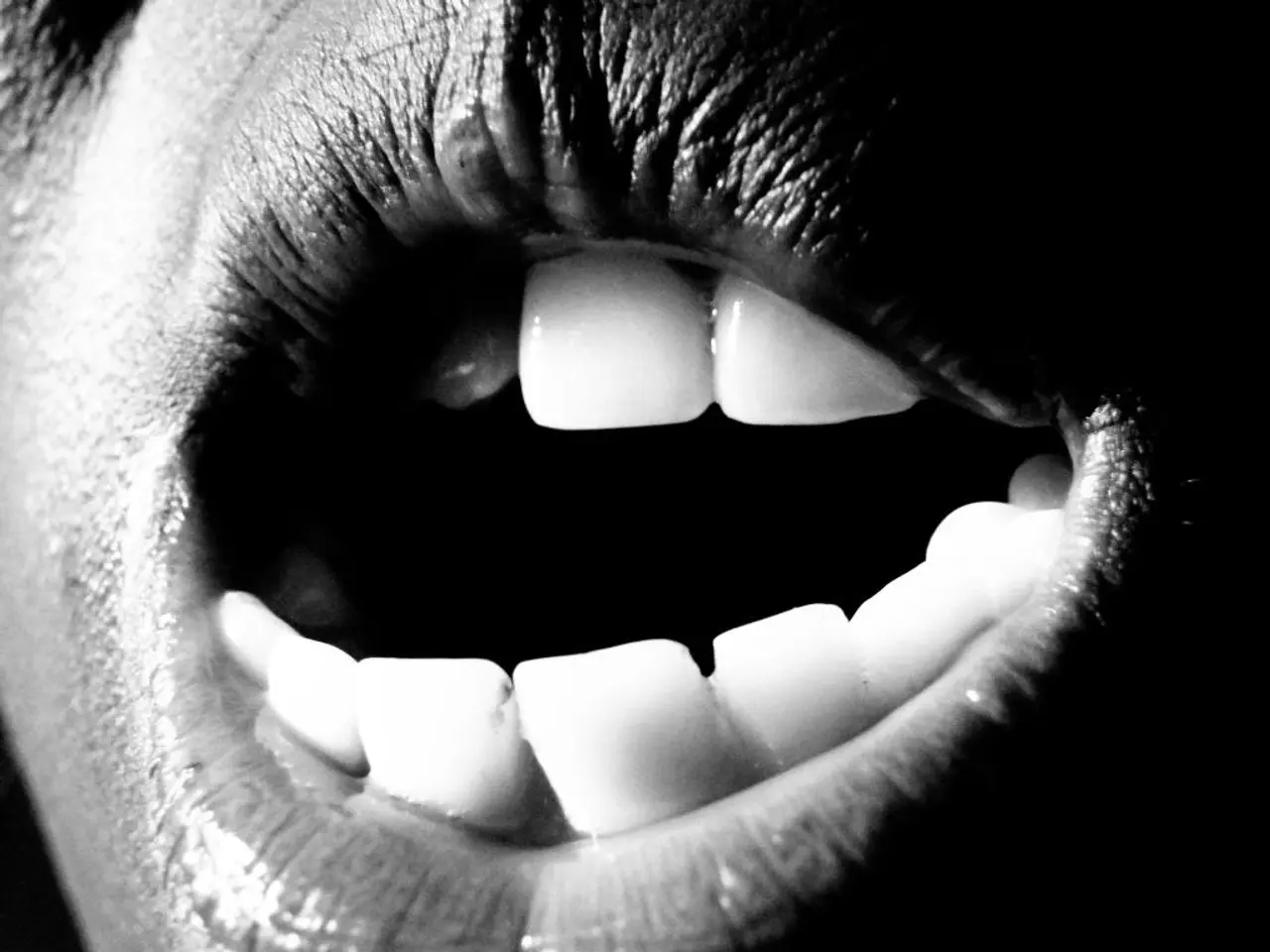Tongue Spots: Understanding Potential Causes and Appropriate Medical Consultation
Unusual spots on the tongue can be a cause for concern, but understanding their potential causes and treating them promptly can help alleviate any discomfort and prevent more serious conditions. Here's a guide to common causes, symptoms, and treatments for spots on the tongue.
Tongue cancer, a form of head and neck cancer, is associated with drinking alcohol, smoking, and infection with the human papillomavirus (HPV). Symptoms include a bump or spot on the side of the tongue, a red patch on the tongue, a sore throat that lasts for a long time, pain when swallowing, and numbness in the mouth. However, it's important to note that most unusual spots on the tongue are not cancerous and are caused by a variety of less severe conditions.
Common causes of unusual spots on the tongue include white spots or patches, dark or brown spots, and yellowish discoloration.
White spots or patches can be caused by oral thrush, leukoplakia, lichen planus, geographic tongue, poor oral hygiene, dry mouth, smoking, or certain medications. Oral thrush, for example, is a fungal infection that leads to creamy white patches that can be wiped off, often accompanied by burning sensations or bad breath. Leukoplakia, on the other hand, are hard, raised white areas that do not scrape off and may potentially be a precancerous condition.
Dark or brown spots can be due to hyperpigmentation, lingual melanotic macules, oral hairy tongue, injuries or irritations, or staining from food and drink. Hyperpigmentation is an increase in melanin, causing harmless dark patches, while lingual melanotic macules are tiny, stable brown or black spots, usually harmless.
Yellowish discoloration is often due to poor oral hygiene, dry mouth, or food and drink staining.
Treatments for unusual spots on the tongue include maintaining good oral hygiene, addressing dry mouth, avoiding irritants, medical treatment for infections, monitoring and evaluation for precancerous or cancerous changes, and tongue cleaning for conditions like oral hairy tongue.
If unusual spots on the tongue persist, change in size or shape, cause pain, or are accompanied by other symptoms, it's essential to seek professional dental or medical advice. A tongue burn caused by hot food or liquid can cause blisters that appear as small, fluid-filled spots on the tongue. Blisters heal more quickly if they remain unbroken and can be promoted to heal by avoiding spicy foods, hot liquids or food, not sucking sweets, brushing teeth with care, and keeping the mouth clean with mouthwash.
Canker sores, or aphthous ulcers, are small ulcers that look white or yellow and can appear on the tongue, inside of the mouth, and on the lips. Lie bumps, a condition characterized by small red or white bumps on the tongue, can also occur and are caused by injury, viruses, psychological stress, or poor nutrition.
Oral yeast infection, or oral thrush, can affect the mouth and tongue, causing white spots, bumps, or patches on the inside surfaces of the mouth, a bad taste, and pain or soreness inside the mouth. Oral yeast infection is rare in healthy adults, but certain groups are at risk, including newborn babies, people who wear retainers or dentures, people with diabetes, people receiving chemotherapy, people living with HIV, people using corticosteroid inhalers for asthma or COPD, and people who smoke or use antibiotics.
Healthy tongue spots are called papillae, and there are four types: fungiform papillae, circumvallate papillae, foliate papillae, and filiform papillae. Each type contains a different number of taste buds and helps with taste, temperature, chewing food, and speaking.
If you have red or white patches on the tongue, severe or unexplained tongue pain or itchiness lasting several days, hard lumps, bumps, or sores on the tongue, spots that bleed, become more painful, or spread, you should see a dentist or doctor. Oral allergy syndrome can cause itching and swelling in the mouth or on the tongue, particularly from certain raw fruits and vegetables. The reaction can be avoided by cutting out the foods that cause the allergy, cooking or peeling the fruit or vegetable.
By understanding the potential causes of unusual spots on the tongue, one can take appropriate action to maintain oral health and prevent more serious conditions. It's always best to consult a healthcare professional for diagnosis and specific management.
- Unusual spots on the tongue may be a sign of tongue cancer, a form of head and neck cancer, associated with alcohol consumption, smoking, and HPV infection.
- Symptoms of tongue cancer include a bump or spot on the side of the tongue, a red patch, a long-lasting sore throat, pain during swallowing, and mouth numbness.
- However, most tongue spots are not cancerous and are caused by various less severe conditions.
- White spots or patches on the tongue can be caused by oral thrush, leukoplakia, lichen planus, geographic tongue, poor oral hygiene, dry mouth, smoking, or certain medications.
- Oral thrush is a fungal infection causing creamy white patches that can be wiped off, often with accompanying burning sensations or bad breath.
- Leukoplakia are hard, raised white areas that do not scrape off and may potentially be a precancerous condition.
- Dark or brown spots on the tongue can be due to hyperpigmentation, lingual melanotic macules, oral hairy tongue, injuries or irritations, or food and drink staining.
- Hyperpigmentation causes dark patches due to an increase in melanin, while lingual melanotic macules are tiny, stable brown or black spots, usually harmless.
- Yellowish discoloration on the tongue is often due to poor oral hygiene, dry mouth, or food and drink staining.
- Treatments for tongue spots include maintaining good oral hygiene, addressing dry mouth, avoiding irritants, medical treatment for infections, monitoring and evaluation for precancerous or cancerous changes, and tongue cleaning for conditions like oral hairy tongue.
- If tongue spots persist, change in size or shape, cause pain, or are accompanied by other symptoms, seek professional dental or medical advice.
- A tongue burn caused by hot food or liquid can cause blisters appearing as small, fluid-filled spots on the tongue.
- To promote healing of blisters, avoid spicy foods, hot liquids or food, don't suck sweets, brush teeth with care, and keep the mouth clean with mouthwash.
- Canker sores, or aphthous ulcers, are small ulcers that look white or yellow and can appear on the tongue, inside of the mouth, and on the lips.
- Lie bumps, a condition with red or white bumps on the tongue, can occur due to injury, viruses, psychological stress, or poor nutrition.
- Oral yeast infection, or oral thrush, can affect the mouth and tongue, causing white spots, bumps, or patches on the inside surfaces of the mouth, a bad taste, and pain or soreness inside the mouth.
- Healthy tongue spots are called papillae, with four types: fungiform papillae, circumvallate papillae, foliate papillae, and filiform papillae.
- Each papilla type contains a different number of taste buds and helps with taste, temperature, chewing food, and speaking.
- Red or white patches on the tongue, severe or unexplained tongue pain or itchiness lasting several days, hard lumps, bumps, or sores on the tongue, spots that bleed, become more painful, or spread should be examined by a dentist or doctor.
- Oral allergy syndrome can cause itching and swelling in the mouth or on the tongue, particularly from certain raw fruits and vegetables.
- To avoid oral allergy symptoms, cut out the foods that cause the allergy, or cook or peel the fruit or vegetable.
- Understanding the potential causes of tongue spots helps maintain oral health and prevent more serious conditions.
- Always consult a healthcare professional for diagnosis and specific management.
- Tongue spots can also be a sign of multiple chronic diseases like cancer, respiratory conditions, digestive-health issues, eye-health concerns, hearing problems, and mental-health issues.
- Autoimmune-disorders, cardiovascular-health problems, neurological-disorders, skin-conditions, and environmental-science can also be indicated by tongue spots.
- Climate-change, finance, skin-care, therapies-and-treatments, lifestyle, fashion-and-beauty, food-and-drink, investing, wealth-management, home-and-garden, business, personal-finance, banking-and-insurance, gadgets, data-and-cloud-computing, technology, artificial-intelligence, relationships, pets, travel, cars, books, education-and-self-development, shopping, social-media, movies-and-tv, entertainment, celebrities, music, politics, pop-culture, sci-fi-and-fantasy, general-news, crime-and-justice, accidents are not directly related to tongue spots.
- Aq, nondigestive ulcers, fevers, oral cancers, and multiple predictive science are not relevant to the discussion about tongue spots.
- Nsclc is a type of cancer that usually affects the lungs rather than the tongue.
- Ideally,monitor medical-conditions, chronic-diseases, and keep up with appointments with a healthcare professional to ensure timely diagnosis and treatment.
- Seek professional dental and medical advice if you notice any worrying changes in your tongue or experience any accompanying symptoms.
- Early detection and treatment of tongue spots can help prevent more serious conditions and ensure proper oral health.
- Maintain good oral hygiene, avoid smoking, limit alcohol consumption, and practice a balanced diet to support overall health and wellness.
- In summary, understanding the causes, symptoms, and treatments for spots on the tongue can help alleviate discomfort, prevent more serious conditions, and maintain proper oral health.




